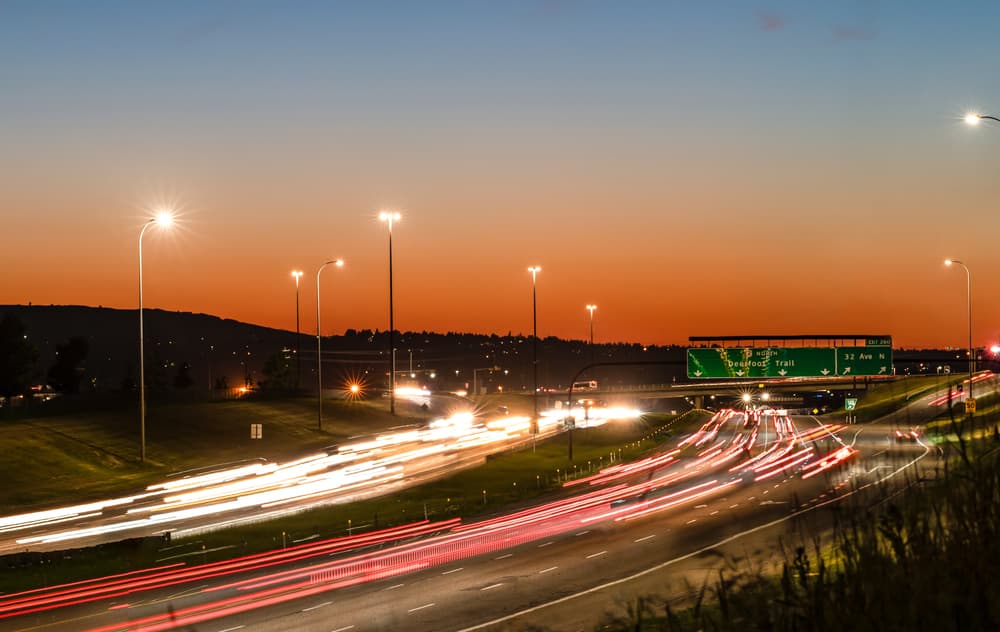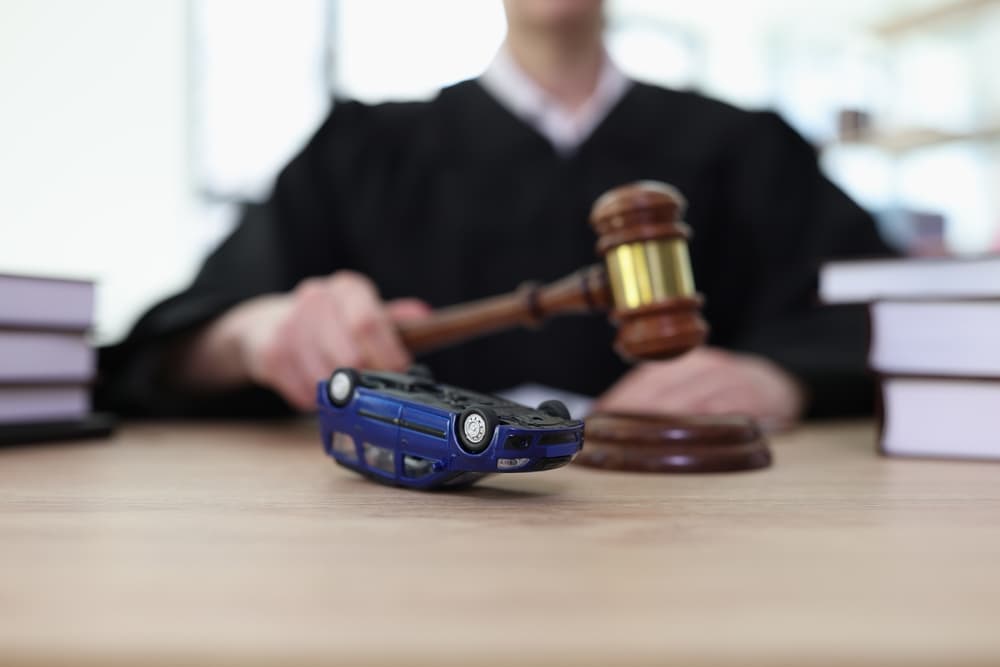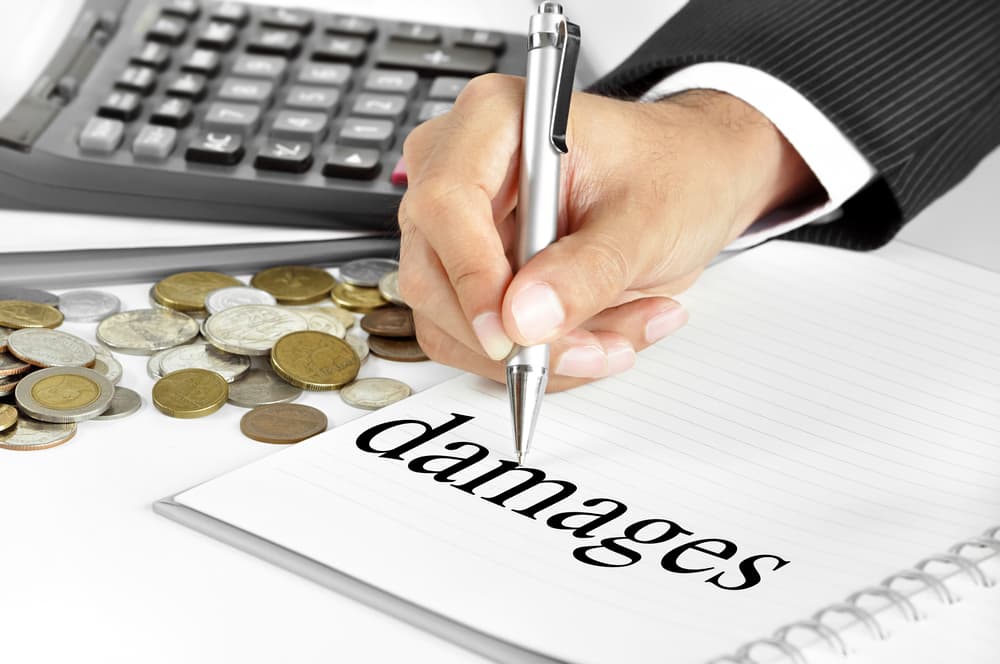Deerfoot Trail – a major roadway in Calgary, Alberta – is unfortunately prone to serious accidents that result from others’ negligence. If you suffered injuries in an accident that happened on Deerfoot Trail, it’s essential that you reach out to a knowledgeable Calgary car accident lawyer for representation right away. Throughout the proceedings, your lawyer will aggressively advocate for your interests, keep you informed, and work to secure the favourable compensation you deserve for your losses.
How do Accidents on Deerfoot Trail Frequently Occur?

Motor vehicle accidents on Deerfoot Trail are an unfortunately all-too-common occurrence. Some of the most frequent types and causes of accidents that occur on this busy thoroughfare include:
- Rear-end collisions – Rear-end collisions are a frequent occurrence on Deerfoot Trail, often due to tailgating, distracted driving, or sudden stops. Drivers may fail to maintain a safe following distance or become distracted with their phones, resulting in rear-end collisions when traffic slows or stops unexpectedly.
- Intersection accidents – Deerfoot Trail intersects with numerous other roads and highways, increasing the risk of intersection accidents. These accidents may occur due to running red lights, failing to yield the right-of-way, or making improper turns.
- Sideswipe incidents – Sideswipe incidents occur when the sides of vehicles collide with each other, often while changing lanes or merging onto Deerfoot Trail. These accidents can happen when other drivers fail to check blind spots, signal improperly, or drift out of their travel lanes. Sideswipe incidents may result in minor to moderate damage to vehicles and may cause injuries if drivers lose control.
- Multi-vehicle pile ups – Due to the high volume of traffic on Deerfoot Trail, multi-vehicle pile ups are not uncommon. These accidents can occur due to various factors, including speeding, reckless driving, and adverse weather conditions. A single negligent driver can trigger a chain reaction of collisions involving multiple vehicles, leading to significant property damage and injuries.
- Distracted driving accidents – Distracted driving is a leading cause of accidents on Deerfoot Trail, as elsewhere. Drivers may become distracted with their phones, vehicle passengers, or other activities, taking their attention off the road and increasing the risk of accidents. Even a momentary distraction can have serious consequences on a busy roadway like Deerfoot Trail.
If you suffered injuries in one of these types of accidents on Deerfoot Trail, a Calgary car accident lawyer is ready to assist you. Your lawyer can swiftly begin an investigation into your accident circumstances and gather the documents necessary to file a personal injury claim.
Common Injuries in an Accident on Deerfoot Trail
Accidents on Deerfoot Trail in Calgary can result in a range of injuries, varying in severity depending upon the crash circumstances. Some of the most common injuries that individuals may suffer in these accidents include:
- Whiplash – Whiplash is a common injury in rear-end collisions, which are frequent occurrences on Deerfoot Trail. It occurs when the victim’s head is suddenly jerked backwards and then forwards, causing strain to the neck ligaments and muscles. Symptoms of whiplash may include neck pain, stiffness, headaches, and difficulty moving the neck.
- Soft Tissue Injuries – Soft tissue injuries involve damage to muscles, tendons, and ligaments and may occur in any type of car accident on Deerfoot Trail. These injuries may result in pain, swelling, bruising, and limited range of motion. Soft tissue injuries can vary in severity and may require rest, physical therapy, and pain management techniques to bring about healing.
- Fractures – Fractures, or broken bones, can occur in high-impact collisions on Deerfoot Trail, such as multi-vehicle pile ups or accidents involving high speeds. Common fractures include broken arms, legs, ribs, and collarbones. Depending upon the severity of the fracture, treatment may involve immobilization with casts or splints, surgery, and rehabilitation.
- Head Injuries – Head injuries are a serious concern in car accidents on Deerfoot Trail, particularly if the collision involves high speeds. Head injuries can range from concussions and minor bumps to traumatic brain injuries (TBIs), which can have long standing consequences. Symptoms may include headaches, dizziness, confusion, nausea, and loss of consciousness.
- Back and Spinal Cord Injuries – Back injuries and spinal cord injuries can occur in various accidents on Deerfoot Trail – especially in collisions involving significant force. These injuries can cause severe pain, paralysis, and loss of sensation or movement below the injury site. Treatment may involve surgery, rehabilitation, and long-term care.
- Psychological Trauma – In addition to physical injuries, individuals involved in accidents on Deerfoot Trail may experience psychological trauma, such as post-traumatic stress disorder (PTSD), anxiety, and depression. The emotional effect of a car accident can be significant and may require therapy or counselling sessions to address.
Seeking prompt medical attention after an accident is crucial to ensure that your injuries are properly diagnosed and treated. While you focus your full attention on your medical recovery, an experienced Calgary car accident lawyer can begin handling the legal steps of your case.
Legal Elements of an Accident Case

Proving the legal elements of an accident on Deerfoot Trail in Calgary requires establishing several key factors:
- Duty of Care – The first element to prove is that the at-fault party owed a duty of care to the victim. In the context of a car accident, all drivers have a duty to drive safely – and to follow all traffic laws while driving on Deerfoot Trail. This duty includes obeying speed limits, signalling turns and lane changes, and maintaining a safe distance from other vehicles.
- Breach of the Legal Duty – The next step is to demonstrate that the at-fault party breached their duty of care by engaging in negligent or reckless behaviour. This can include actions like speeding, running red lights, distracted driving, or driving under the influence of drugs or alcohol. Breaching the duty of care means failing to uphold the standard of care expected of a reasonable driver in similar circumstances.
- Causation – After establishing negligence, the victim must prove that the at-fault party’s breach caused the accident and resulting injuries. This requires showing that the other driver’s actions were a direct and foreseeable cause of the accident. Causation can be complex to prove – especially in cases where multiple factors contributed to the accident.
- Damages – Finally, the victim must demonstrate that they suffered actual damages as a result of the accident. This can include physical injuries, lost wages, pain and suffering, and emotional distress. Documenting and quantifying damages is essential for building a strong case for compensation.
To prove these legal elements, evidence is crucial. This can include police reports, eyewitness testimony, photographs of the accident scene, medical records documenting injuries, and expert testimony from accident reconstruction specialists or medical professionals. Witness statements, surveillance footage, and data from vehicle black boxes may also be valuable pieces of evidence in establishing negligence and causation.
It’s important to note that proving negligence in a car accident case can be complex and may require the experience of a skilled Calgary personal injury lawyer. A lawyer can gather evidence, assess the strength of your case, and navigate the legal process to pursue maximum compensation for your injuries.
Settlement and Litigation Options after an Accident on Deerfoot Trail
Following an accident on Deerfoot Trail in Calgary, individuals have several options for pursuing compensation, including settlement negotiations and litigation:
One option is to attempt to settle the case out of court through negotiations with the at-fault party or their insurance company. In settlement negotiations, both parties and their legal representatives discuss the details of the accident, the extent of the victim’s injuries, and potential compensation. If an agreement is reached, the case can be resolved without the need for a trial. In general, settlement negotiations can be a faster and less costly option than litigation, and they allow the parties to retain more control over the outcome of the case.
Another option is mediation – a voluntary process in which a neutral third party, known as a mediator, facilitates communication and negotiation between the parties involved in the accident. Mediation can be an effective way to resolve disputes without the need for litigation. The mediator helps the parties identify common ground and reach a mutually acceptable resolution. If successful, the terms of the settlement are documented in a written agreement.
On the other hand, arbitration is a more formal alternative to mediation, in which a neutral third party – known as an arbitrator – hears arguments and evidence from both sides and makes a binding decision to resolve the dispute. Arbitration can be either binding or non-binding, depending upon the agreement of the parties involved. In binding arbitration, the arbitrator’s decision is final and legally enforceable, while in non-binding arbitration, the parties may choose to accept or reject the arbitrator’s decision.
If settlement negotiations, mediation, or arbitration are unsuccessful, individuals may choose to pursue litigation through the court system. Litigation involves filing a lawsuit against the at-fault party and presenting evidence and arguments in court. The case proceeds through various stages, including discovery, pre-trial motions, and, ultimately, a trial, where a judge or jury decides the outcome. Litigation can be a lengthy and costly process, but it may be necessary to obtain a fair outcome – especially if the parties cannot agree on liability or damages.
Each of these options has its advantages and disadvantages, and the best approach will depend upon the specific circumstances of your case – and your ultimate goals. An experienced Calgary car accident lawyer can help you make important decisions, including whether to accept a particular settlement offer or pursue litigation in the Alberta Court System.
Recovering the Monetary Damages You Need

Following an accident on Deerfoot Trail, individuals may be entitled to various types of monetary damages to compensate them for their injuries and losses. These damages can include:
- Lost Income – Individuals who are out of work due to their car accident injuries may be entitled to compensation for lost income. This includes income lost immediately after the accident, as well as anticipated lost earnings.
- Loss of Earning Capacity – In cases where an accident victim suffers permanent injuries, they may be entitled to compensation for loss of earning capacity. These damages compensate accident victims whose injuries prevent them from working at the same job – or in the same capacity – resulting in reduced income.
- Pain and Suffering – Pain and suffering damages are necessary to compensate individuals for the physical pain, emotional distress, and mental anguish that result from the car accident and their injuries. These damages are more subjective than economic damages and can vary significantly, depending upon the severity of the injuries and their effect on the individual’s life.
- Lost Quality of Life – Victims may also recover compensation for their loss of life enjoyment – especially if their injuries prevent them from partaking in recreational activities, sports, or social events that they once enjoyed.
- Loss of Consortium – In cases where the car accident results in serious injuries that affect the individual’s relationships with others (including a spouse), the injured party or their family may be entitled to compensation for loss of consortium. This can include loss of companionship, intimacy, and support.
- Punitive Damages – In cases where the at-fault party’s conduct was particularly reckless or egregious (such as in a drunk driving accident case), the court may award punitive damages to punish the wrongdoer and deter similar behaviour in the future. Punitive damages serve as a deterrent and are available in addition to compensatory damages.
Seeking legal representation from an experienced car accident lawyer in Calgary can help to ensure that individuals receive fair compensation for their accident-related losses.
Speak with an Experienced Car Accident Lawyer in Calgary Today
When other drivers are reckless on Deerfoot Trail in Calgary, serious accidents can result. If you or someone you love suffered injuries in a recent car crash, you need to take swift action. If you wait too long to file a claim or lawsuit, you may inadvertently jeopardize your right to recover the compensation you need.
An experienced personal injury lawyer in Calgary can file a timely claim or lawsuit in your case, aggressively negotiate with insurance company representatives, and pursue the full compensation you deserve for your injuries.
